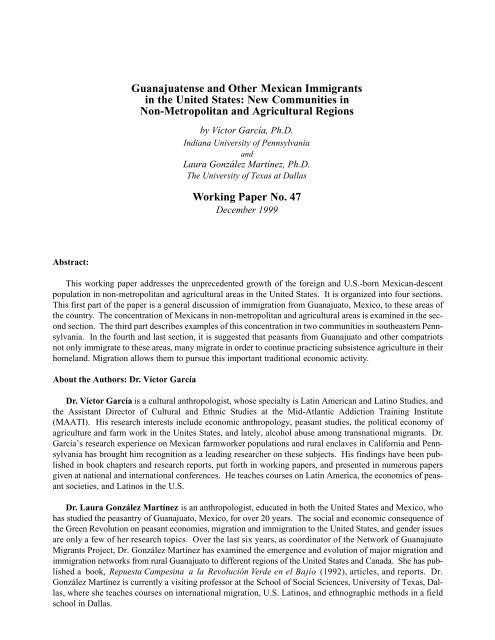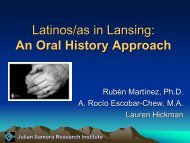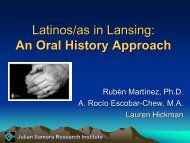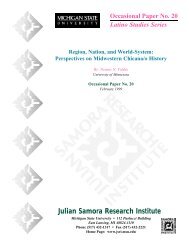Guanajuatense and Other Mexican Immigrants in the United States ...
Guanajuatense and Other Mexican Immigrants in the United States ...
Guanajuatense and Other Mexican Immigrants in the United States ...
You also want an ePaper? Increase the reach of your titles
YUMPU automatically turns print PDFs into web optimized ePapers that Google loves.
<strong>Guanajuatense</strong> <strong>and</strong> <strong>O<strong>the</strong>r</strong> <strong>Mexican</strong> <strong>Immigrants</strong><strong>in</strong> <strong>the</strong> <strong>United</strong> <strong>States</strong>: New Communities <strong>in</strong>Non-Metropolitan <strong>and</strong> Agricultural Regionsby Víctor García, Ph.D.Indiana University of Pennsylvania<strong>and</strong>Laura González Martínez, Ph.D.The University of Texas at DallasWork<strong>in</strong>g Paper No. 47December 1999Abstract:This work<strong>in</strong>g paper addresses <strong>the</strong> unprecedented growth of <strong>the</strong> foreign <strong>and</strong> U.S.-born <strong>Mexican</strong>-descentpopulation <strong>in</strong> non-metropolitan <strong>and</strong> agricultural areas <strong>in</strong> <strong>the</strong> <strong>United</strong> <strong>States</strong>. It is organized <strong>in</strong>to four sections.This first part of <strong>the</strong> paper is a general discussion of immigration from Guanajuato, Mexico, to <strong>the</strong>se areas of<strong>the</strong> country. The concentration of <strong>Mexican</strong>s <strong>in</strong> non-metropolitan <strong>and</strong> agricultural areas is exam<strong>in</strong>ed <strong>in</strong> <strong>the</strong> secondsection. The third part describes examples of this concentration <strong>in</strong> two communities <strong>in</strong> sou<strong>the</strong>astern Pennsylvania.In <strong>the</strong> fourth <strong>and</strong> last section, it is suggested that peasants from Guanajuato <strong>and</strong> o<strong>the</strong>r compatriotsnot only immigrate to <strong>the</strong>se areas, many migrate <strong>in</strong> order to cont<strong>in</strong>ue practic<strong>in</strong>g subsistence agriculture <strong>in</strong> <strong>the</strong>irhomel<strong>and</strong>. Migration allows <strong>the</strong>m to pursue this important traditional economic activity.About <strong>the</strong> Authors: Dr. Víctor GarcíaDr. Víctor García is a cultural anthropologist, whose specialty is Lat<strong>in</strong> American <strong>and</strong> Lat<strong>in</strong>o Studies, <strong>and</strong><strong>the</strong> Assistant Director of Cultural <strong>and</strong> Ethnic Studies at <strong>the</strong> Mid-Atlantic Addiction Tra<strong>in</strong><strong>in</strong>g Institute(MAATI). His research <strong>in</strong>terests <strong>in</strong>clude economic anthropology, peasant studies, <strong>the</strong> political economy ofagriculture <strong>and</strong> farm work <strong>in</strong> <strong>the</strong> Unites <strong>States</strong>, <strong>and</strong> lately, alcohol abuse among transnational migrants. Dr.García’s research experience on <strong>Mexican</strong> farmworker populations <strong>and</strong> rural enclaves <strong>in</strong> California <strong>and</strong> Pennsylvaniahas brought him recognition as a lead<strong>in</strong>g researcher on <strong>the</strong>se subjects. His f<strong>in</strong>d<strong>in</strong>gs have been published<strong>in</strong> book chapters <strong>and</strong> research reports, put forth <strong>in</strong> work<strong>in</strong>g papers, <strong>and</strong> presented <strong>in</strong> numerous papersgiven at national <strong>and</strong> <strong>in</strong>ternational conferences. He teaches courses on Lat<strong>in</strong> America, <strong>the</strong> economics of peasantsocieties, <strong>and</strong> Lat<strong>in</strong>os <strong>in</strong> <strong>the</strong> U.S.D r. Laura González Martínez is an anthropologist, educated <strong>in</strong> both <strong>the</strong> <strong>United</strong> <strong>States</strong> <strong>and</strong> Mexico, whohas studied <strong>the</strong> peasantry of Guanajuato, Mexico, for over 20 years. The social <strong>and</strong> economic consequence of<strong>the</strong> Green Revolution on peasant economies, migration <strong>and</strong> immigration to <strong>the</strong> <strong>United</strong> <strong>States</strong>, <strong>and</strong> gender issuesare only a few of her research topics. Over <strong>the</strong> last six years, as coord<strong>in</strong>ator of <strong>the</strong> Network of GuanajuatoMigrants Project, Dr. González Martínez has exam<strong>in</strong>ed <strong>the</strong> emergence <strong>and</strong> evolution of major migration <strong>and</strong>immigration networks from rural Guanajuato to different regions of <strong>the</strong> <strong>United</strong> <strong>States</strong> <strong>and</strong> Canada. She has publisheda book, Repuesta Campes<strong>in</strong>a a la Revolución Ve rde en el Bajío (1992), articles, <strong>and</strong> reports. Dr.González Martínez is currently a visit<strong>in</strong>g professor at <strong>the</strong> School of Social Sciences, University of Texas, Dallas,where she teaches courses on <strong>in</strong>ternational migration, U.S. Lat<strong>in</strong>os, <strong>and</strong> ethnographic methods <strong>in</strong> a fieldschool <strong>in</strong> Dallas.







